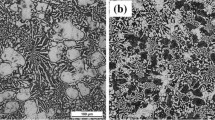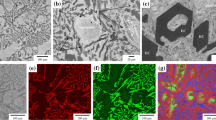Abstract
The influence of annealing on the mechanical properties of high-silicon cast iron for three alloys with distinct chromium levels was investigated. Each alloy was melted either with or without the addition of Ti and Mg. These changes in the chemical composition and heat treatment aimed to improve the material’s mechanical properties by inhibiting the formation of large columnar crystals, netlike laminae, precipitation of coarse packs of graphite, changing the length and morphology of graphite, and rounding the extremities of the flakes to minimize the stress concentration. For alloys with 0.07 wt.% Cr, the annealing reduced the impact resistance and tensile strength due to an enhanced precipitation of refined carbides and the formation of interdendritic complex nets. Annealing the alloys containing Ti and Mg led to a decrease in the mechanical strength and an increase in the toughness. Alloys containing approximately 2 wt.% Cr achieved better mechanical properties as compared to the original alloy. However, with the addition of Ti and Mg to alloys containing 2% Cr, the chromium carbide formation was inhibited, impairing the mechanical properties. In the third alloy, with 3.5 wt.% of Cr additions, the mechanical strength improved. The annealing promoted a decrease in both hardness and amount of iron and silicon complex carbides. However, it led to a chromium carbide formation, which influenced the mechanical characteristics of the matrix of the studied material.






Similar content being viewed by others
References
J. Mechura, J. Klaban, Improving Properties of High-Silicon Iron Alloys, Foundry Trade J., April, 1970, p 721–728
A. Reynaud, High-Chromium and High-Silicon Cast Irons, Mater. Sel. Des., February, 1996, p 93–95
ASM International, Properties and Selection: Irons, Steels and High-Performance Alloys, 20th ed., Vol 1, Metals Handbook, 1990
B.H. Kim, J.S. Shin, S.M. Lee, and B.M. Moon, Improvement of Tensile Strength and Corrosion Resistance of High-Silicon Cast Irons by Optimizing Casting Process Parameters, J. Mater. Sci., 2007, 42, p 109–117
J. Dodd, Microstructures and Notes on Acid-Resisting High Silicon Iron Casting, Br. Foundrym., 1961, 54, p 277–279
M.G. Fontana, Sixth of a Series Summarizing Corrosion Data in Chart Form Presents Concentrations and Temperatures for Corrosion of High Silicon Iron by Sulfuric Acid, Ind. Eng. Chem., 1952, 44(2), p 85–88A
R.V. Riley, J.R. Park, K. Southwick, Cast and High Silicon Iron, Chem. Ind., January, 1951, p 64
J.E. Hurst, High-Si Acid-Resisting Cast Iron, Foundry Trade J., 1943, 2, p 283–289
J.E. Hurst and R.V. Riley, The Occurrence of the Carbide Phase in High-Silicon Iron-Carbon Alloys, J. Iron Steel Inst., 1944, 149, p 213–219
M.G. Fontana, Corrosion of High Silicon Iron by Nitric Acid as a Function of Temperature is Summarized in Chart Form, Ind. Eng. Chem., 1953, 45(5), p 91–94A
S. Banerjee and R.K. Dutta, Complexometric Determination of Magnesium in Nodular Cast Iron and Alloyed Cast Iron Roll Samples, Talanta, 1980, 27, p 212–213
J.L. Hague and J.I. Shultz, Determination of Magnesium in Cast Iron, Foundry, 1950, 78(10), p 92
J. Berendson and G. Wranglén, Magnesium Sulphide as the Cause of the Higher Corrodibility of Nodular Cast Iron as Compared to Grey Cast Iron, Corros. Sci., 1980, 20, p 937–941
D. Zeng, Y. Zhang, J. Liu, H. He, and X. Hong, Characterization of Titanium-Containing Compounds in Gray Iron, Tsinghua Sci. Technol., 2008, 13, p 127–131
G. Cueva, A. Sinatora, W.L. Guesser, and A.P. Tschiptschin, Wear Resistance of Cast Irons Used in Brake Disc Rotors, Wear, 2003, 255, p 1256–1260
ASTM A-518M, “Standard Specification for Corrosion-Resistant High-Silicon Iron Castings,” Designation A518/518M-99, 1999, p 1–6
Acknowledgments
The authors would like to acknowledge FAPESP for the financial support given, Fultec Inox Ltd. partnership in this project, as well as the Materials, Aeronautics and Automotive Engineering Department, Engineering School of São Carlos—USP, for granting us the use of its facilities.
Author information
Authors and Affiliations
Corresponding author
Rights and permissions
About this article
Cite this article
Castro, D.B.V., Rossino, L.S., Malafaia, A.M.S. et al. Influence of Annealing Heat Treatment and Cr, Mg, and Ti Alloying on the Mechanical Properties of High-Silicon Cast Iron. J. of Materi Eng and Perform 20, 1346–1354 (2011). https://doi.org/10.1007/s11665-010-9733-y
Received:
Revised:
Published:
Issue Date:
DOI: https://doi.org/10.1007/s11665-010-9733-y




